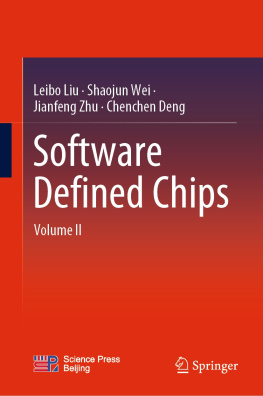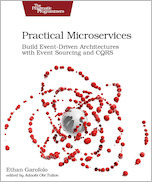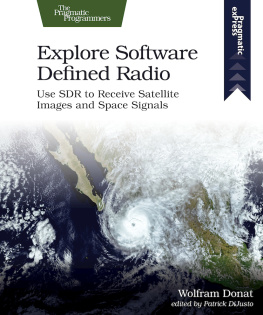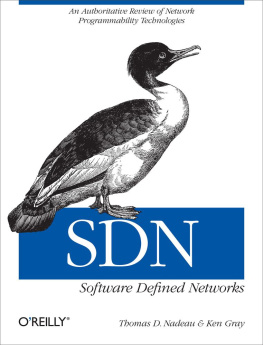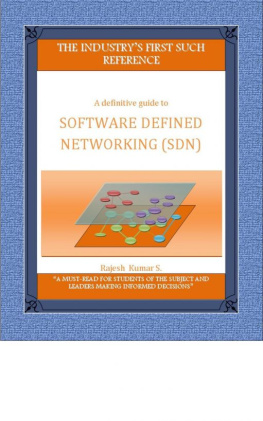THE HOBBYISTS GUIDE TO THE RTL-SDR:
REALLY CHEAP SOFTWARE DEFINED RADIO
A GUIDE TO THE RTL-SDR AND CHEAP SOFTWARE DEFINED RADIO BY THE AUTHORS OF THE RTL-SDR.COM BLOG
TABLE OF CONTENTS
PREFACE
In February 2012 the first FM radio signal was received with an RTL2832U RTL-SDR dongle using custom SDR drivers. Since then tens of thousands of hams, security researchers, hackers, makers, tinkerers, students and electronics enthusiasts have purchased RTL-SDR dongles to use as a very cheap software defined radio.
This book is intended to be a comprehensive guide for hobbyists on the use of the RTL-SDR dongle. The book consists mainly of tips to get the best out of your RTL-SDR and tutorials for some of the various interesting projects that can be done using the dongle.
The information and tutorials in this book are up to date at the time of writing. Because SDR technology and its supporting software is evolving at such a fast pace, we cannot guarantee that they will work without the need for some tweaking in the future. We will do our best to keep this book updated and will aim for an update schedule of every 3 - 4 months. To receive the updates you will need to manually contact Kindle support by email and request the update. We cannot push updates out automatically as this would disrupt peoples bookmarks, highlights and notes. You can see the edition the book is up to on the Amazon sales page.
If you discover any mistakes, missing information or just have any feedback on the book please feel free to contact me at rtlsdrblog@gmail.com.
If you are unsatisfied with this book in any way, remember that it can always be refunded through Amazon within 7 days of the purchase. But if you enjoy this book we would very much appreciate it if you were to leave us good review on the Amazon store page.
Tips for reading on Kindle: Be sure to adjust the font size settings to your preference as the default font size can be very large. All Kindle readers have this setting in their options or tool bars. It is also recommended to read this book in two column mode if reading on a PC. The free Calibre software is a good alternative to the Kindle software for reading this book. This book has DRM disabled, so feel free to use Calibre to convert it into a PDF or what ever document format you prefer.
INTRODUCTION
WHAT IS SOFTWARE DEFINED RADIO (SDR)?
In traditional hardware radios, the mathematical operations required to decode and process radio signals are performed using analogue circuitry.
Recently, computers have become powerful enough to perform the required mathematical calculations in software, hence the term software defined radio.
This has led to the creation of advanced radios that previously required complicated analogue hardware now being able to be implemented easily in software. Advanced radio capabilities such as wideband tuning and waterfall displays are now available at much lower costs.
WHAT IS THE RTL-SDR?
The RTL-SDR is an extremely cheap software defined radio which is based on mass produced DVB-T TV (Digital HD TV) USB receiver dongles that have the RTL2832U chip in them. Back in 2012 it was discovered by hardware hacker Eric Fry, Linux driver developer Antti Palosaari and the Osmocom team (who were developing their own SDR) that the RTL2832U chip had a special mode which enabled it to be used as a general wideband SDR.
Today, by using custom software drivers, a commonly found and low cost TV dongle (under $20 USD) can be turned into a sophisticated SDR receiver with features that would have until recently cost in the hundreds to thousands of dollars.
Of course, the performance of these dongles will not match a dedicated SDR, but they perform extremely well for the price and almost all hobbyist projects that can be done with expensive radios or SDRs can also be done with the RTL-SDR. Also because the RTL-SDR has become so ubiquitous it also has the advantage of a large community, meaning that there is a greater amount of free software available.
Owning a wideband SDR opens up many interesting possible projects and avenues to explore. Applications of the RTL-SDR include the following, some of which will be discussed in more depth in the project tutorials chapter.
- Listening to unencrypted Police/Ambulance/Fire/EMS conversations.
- Listening to aircraft traffic control conversations.
- Tracking aircraft positions like a radar with ADS-B decoding.
- Decoding aircraft ACARS short messages.
- Scanning commercial trunked radio conversations.
- Decoding unencrypted digital voice transmissions.
- Tracking maritime boat positions like a radar with AIS decoding.
- Decoding POCSAG/FLEX pager traffic.
- Scanning for cordless phones and baby monitors.
- Tracking and receiving meteorological agency launched weather balloon data.
- Tracking your own self launched high altitude balloon for payload recovery.
- Receiving ham radio balloons.
- Decoding wireless temperature sensors and wireless power meter sensors.
- Listening to VHF amateur radio.
- Decoding ham radio APRS packets.
- Watching analogue broadcast TV.
- Sniffing and analysing GSM signals.
- Using the RTL-SDR on your Android device as a portable radio scanner.
- Receiving GPS signals and decoding them.
- Using the RTL-SDR as a spectrum analyzer.
- Receiving NOAA and Meteor-M weather satellite images.
- Listening to satellites and the ISS.
- Listening to unencrypted military communications.
- Radio astronomy - observing the hydrogen line and solar activity.
- Monitoring meteor scatter.
- Listening to FM radio and decoding RDS information.
- Listening to DAB broadcast radio.
- Using the RTL-SDR as a panadapter for your traditional hardware radio.
- Decoding taxi mobile data terminal signals.
- Listening to amateur radio hams on SSB with LSB/USB modulation.
- Decoding digital amateur radio ham communications such as CW/PSK/RTTY/SSTV.
- Receiving HF weatherfax.
- Receiving digital radio monodiale shortwave radio (DRM).
- Listening to international shortwave radio.
- Looking for RADAR signals like over the horizon (OTH) radar, CODAR and HAARP signals.
- Using the RTL-SDR as a high quality atmospheric noise entropy source for random number generation.
- Using the RTL-SDR as a noise figure indicator.
- Reverse engineering unknown RF protocols.
- Triangulating the source of a signal.
- Searching for RF noise sources.
- Characterizing RF filters and measuring antenna SWR.
WHAT EQUIPMENT DO I NEED TO GET INTO RTL-SDR?
All that is really needed is the following commonly found equipment:
- An RTL-SDR dongle.
- An antenna for your project (purchased or home built).
- Some coax cable and an adapter to connect the RTL-SDR to the antenna.
- A computer (at least a dual core CPU is recommended), or Linux embedded PC.
- RTL-SDR software and drivers (most software is free).
Furthermore, you can get more advanced with some extras:
- An upconverter to receive the HF bands (0 - 30 MHz).
- A low noise amplifier (LNA) to improve reception.
- Preselector filters to reduce out of band interference and noise.
Places to buy some of these products can be found at http://www.rtl-sdr.com/buy-rtl-sdr-dvb-t-dongles/.
RTL-SDR TECHNICAL SPECIFICATIONS
- 22-2200 MHz tunable range (approx. depends on tuner model).
- 3.2 MHz max bandwidth (~2.8 MHz stable).
- 8-bit ADC (~7 ENOB) giving a little under ~50 dBs of dynamic range.
- < 4.5dB noise figure LNA.
- 75 Ohm input impedance.
RTL-SDR ADC
ADC is an acronym for Analogue to Digital Converter. It is a microchip that reads in an analogue signal voltage and then digitizes it. The more bits an ADC has, the more accurate the digitization can be. For example an 8-bit ADC can scale the analogue input voltage into values between -127 and +127, whereas a 12 bit ADC can scale input voltage from -2047 to +2047.
Next page

